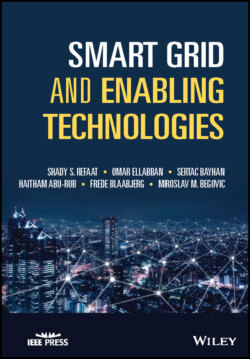Читать книгу Smart Grid and Enabling Technologies - Frede Blaabjerg - Страница 26
1.5 Smart Grid Elements
ОглавлениеThe SG architecture consists of three main systems: power, communication, and information. Proper architecture is necessary to ensure SG functionality. The design and analysis of future SGs require fundamental insight into the impact of power network topology and integrated network control with Big Data utilization. Furthermore, it is essential to have an insight into the complex interaction between the physical layer and cyber layer that includes the supporting communication, information, and computational systems. SG architecture can be represented as a layered structure including the following five main layers as shown in Figure 1.6: System architecture, Distribution Control, Applications, Standards, and Cybersecurity measures.
The grid modernization is expected to make the grid more flexible, accessible, and manageable with interconnected networks consisting of a number of smaller‐sized subsystems integrated with a large number of renewable energy sources. Making the grid more accessible is possible by having grid resources available and considering the access to the loads. The SG serves the needs of multiple stakeholders in the electricity industry. Devices and systems developed individually by different vendors and for different electric utilities are employed by various customers, so they must work together in harmony; these systems must achieve interoperability requirement. The upcoming technology in the SG interoperability framework is the real‐time dynamic control and management systems. The components of SG are the combination of intelligent appliances and equipment that play an important role in the production, delivery, and consumption of electricity. SG elements can be grouped into seven key technology areas [19]. These areas are distributed generation, electric storage system, smart meters, advanced control, integrated communications, sensing and measurement, improved interfaces, and decision support using customer engagement and demand response (DR) as shown in Figure 1.7.
